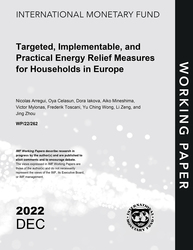
The Impact of the IMF’s COVID-19 Support to Developing and Emerging Economies
The Impact of the IMF’s COVID-19 Support to Developing and Emerging Economies
READ MORE...
Volume/Issue:
Volume 2022
Issue 261
Publication date: December 2022
ISBN: 9798400230165
$0.00
Add to Cart by clicking price of the language and format you'd like to purchase
Available Languages and Formats
| English |
Topics covered in this book
This title contains information about the following subjects.
Click on a subject if you would like to see other titles with the same subjects.
Exports and Imports , Economics- Macroeconomics , Public Finance , Economics / General , Agribusiness , COVID-19 pandemic , External financing , Emerging economies , Developing countries , IMF lending , Economic recovery , Nighttime lights , Mobility , IMF commitment , IMF disbursement , IMF's COVID-19 support , high-frequency dataset , COVID-19 , Income , Emergency assistance , Agroindustries , Global
Summary
We construct a high-frequency dataset that combines information on all IMF lending and proxies of monthly economic activity during the first two years of the COVID-19 pandemic (2020–21). Using this novel dataset and standard econometric techniques we find a positive and significant marginal effect of IMF financing on economic activity in low-income countries (LICs) and emerging market economies. We also present tentative evidence that IMF financing may have helped economic outcomes by easing fiscal budget constraints, allowing for larger government spending in response to the pandemic. Overall, this evidence suggests that IMF financing helped lessen the negative impacts of the pandemic on economic activity, especially in LICs.
Copyright © 2010 - 2025
Powered by:
AIDC



